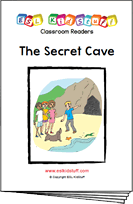Future plans using “going to” lesson plan
Stand-alone lesson ESL kids lesson plan
Lesson plans for ESL kids teachers

Future plans using “going to”
In this lesson, students practice talking about future plans using “going to”. They ask questions, play a board game, read a funny story and write their own classroom reader.
Members get accompanying worksheets and classroom reader.
Download materials:
Our lesson plans are FREE!
Sign up for accompanying:
✔ worksheets
✔ homework sheets
✔ craft sheets
✔ flashcards
✔ song downloads & videos
✔ classroom readers & videos
Click to see lesson details, materials and supplies
Time: 40 mins – 1 hour
Objectives: Talking about future plans using “going to” + infinitive.
Structures: “What are you going to do (this/next weekend / during the summer)?”, “I’m (not) going to…”.
Target vocabulary: go shopping, go to the [hide_on_uk]movie theater[/hide_on_uk][hide_on_us]cinema[/hide_on_us], play a sport, go swimming, go abroad, meet my friends, visit relatives, go to the beach, play video games, watch TV / movies, fly a drone, eat out, go to a party, go dancing, get my hair cut, study, read [hide_on_uk]comic books[/hide_on_uk][hide_on_us]comics[/hide_on_us], exercise, go hiking, sleep a lot.
Lesson materials
Printables:
- Actions charades game cards
- What are you going to do … ? True or false board game (enlarge to A3 if possible)
- Reader worksheet
- Monster story planner worksheet
- Make your own reader – Monster school summer plans (reader template)
- Weekend plans write worksheet
Readers:
- Monster school summer plans
Additional materials:
- Future plans vocab crossword
- Future plansvocab word search
- Future plans worksheet
Supplies:
- [hide_on_uk]colored[/hide_on_uk][hide_on_us]coloured[/hide_on_us] pencils
- photos of two people (see point 4)
- dice – enough for one per group of 2 or 3 students (see point 6)
- counters – enough to give one to each student (see point 6)
- board with marker / chalk
This is a good lesson to do before the summer vacation, so you can get your students talking about their summer plans. However, you can also apply this to weekend plans.
There are a number of ways to form future sentences. When talking about future plans or intentions, using “going to” is a very common method. The following forms are possible:
- positive: I am going to go shopping tomorrow. (subject + to be + going to + infinitive
- negative: I am not going to go shopping tomorrow. (subject + to be + not + going to + infinitive)
- yes/no questions: Are you going to go shopping tomorrow? (to be + subject + going to + infinitive)
- wh questions: What are you going to do tomorrow? Where are you going to go shopping? (wh question + to be + subject + going to + infinitive)
Lesson procedure:
Warm up and maintenance:
The beginning of your lesson is extremely important: this is where you set the tone of your lesson and get everyone in the right frame of mind for learning English. It is also an opportunity to check homework and review previous lessons.
Click for warm up suggestions for the start of your lessons
These activities can be done in the following order at the start of your lesson:

1. Greetings and name tags
Greet the students by name as they enter the classroom and gesture for them to sit down. Before class prepare some blank name tags (stickers or pin-on tags). Give these out and have everyone write their names and put their tags on. If you use pin-on tags, you can keep and give out every class.

2. Homework check
Check each student’s homework set in the last lesson. Ask each student some questions about their homework worksheet (e.g. “what [hide_on_uk]color[/hide_on_uk][hide_on_us]colour[/hide_on_us] is it?”), give lots of praise, and then put some kind of mark on the homework sheet (e.g. a sticker, a stamp or draw a smiley face). Finally, tell your students to put their homework back into their bags.
3. Review past lessons
Reviewing past lessons is very important – students need constant practice of new vocab, structures, songs, games and so on. Always review parts of your last lesson as well as some parts from other previous lessons. You can spend 5-10 minutes reviewing – it’s fine to recycle games and activities from your past lessons to review as kids enjoy playing familiar games (although be careful not to play a game to death!). See the section “Other ideas to include in your warm” below for ideas.
You can also include review activities in the main body of your lesson. Kids can have short attention spans so it’s good to be able to pull out lots of activities during different stages of the lesson.
Other ideas to include in your warm up:
Ball pass questions
This is good to review questions from previous lessons. Get everybody standing in a circle.
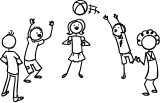
Round 1:
Take a ball and hold it and say, “My name is (you name)”. Then throw the ball to one student and say, “What’s your name?”. Students throw the ball around randomly, saying their names and asking for names.
Round 2:
This time ask a review question, e.g. “How many tables are there?”. Then throw the ball to a student who should answer, “There are (6) tables”. Help if necessary. Then that student throws the ball to another student and asks a “How many …?” question. Continue so everyone has a go. You can have multiple rounds with different topic questions.

Play “Spin the bottle”
Sit students in a circle with a bottle in the middle. Teacher spins the bottle. When it stops spinning the student it is pointing to has to answer a question. If the answer is correct then that student can spin the bottle. This is a good class warm up activity (e.g. How are you? What’s your [hide_on_uk]favorite[/hide_on_uk][hide_on_us]favourite[/hide_on_us] food? How’s the weather today?, etc.
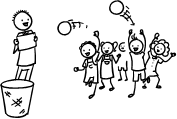
Play “Vocabulary basketball”
This is a fun game which reviews vocabulary from previous lessons. You will need a basket (a trash can) and 2 balls (or 2 pieces of A4 paper scrunched up into balls).
Form 2 teams and line them up so that two players from each team are facing the front with the basket in front of them. Let both players throw their ball – if they get their ball into the basket they can try and win a point by giving the correct answer to a question the teacher asks. This can be an actual question (e.g. What are you wearing?) or a flashcard (What’s this?). Then they go to the back of the line. At the end, the team with the most points is the winner!
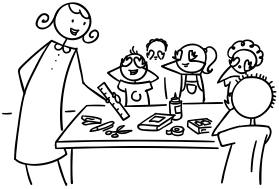
Play “What’s missing?”
This is a fun review memory game – students will have to try to remember review objects from previous lessons (e.g. classroom stationery). Lay the objects out on a table for all to see. Allow the students a minute to memorize the positions of the objects. Remove an object and hold it behind your back. Say, “Open your eyes!” – the first student who can shout out the missing object wins a point for his/her team. Play for all the objects.
Finally, calculate which team has won the most points and give them a round of applause.

Play “Quiz game show”
This is a fun quiz game, like a simple version of a TV game show. Draw some circles on the board and randomly write numbers 1, 2 or 3 in each circle. These will be points.
Put students into teams. Then ask the first team to choose a number – 1 is an easy question (e.g. “Do you like bananas?”) and 3 is a difficult question (e.g. point at a clock and ask, “What time is it?”). 2 will be in between in terms of difficulty. When the question has been answered correctly, erase that number circle. Play until all the number circles are gone – the team with the most points is the winner!
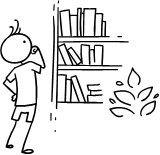
Read a classroom reader again
As you progress through the lessons you will start to build up a catalog of classroom readers (see our Readers download page at https://www.eslkidstuff.com). Kids love going back to old stories and reading through them again. Invite a student to pick a classroom reader and read through it as a class. Make the story as interactive as possible by asking questions (e.g. what [hide_on_uk]colors[/hide_on_uk][hide_on_us]colours[/hide_on_us] there are, the names of different objects, etc.) and getting students to speculate what is going to happen next in the story.

Talk about the weather (do after you have taught the weather lesson plan).
- Prepare a weather board. Before the first class prepare a piece of cardboard and cover it with felt – you are going to pin this to the wall. If you can, try and get blue felt (to represent the sky). Write at the top in large letters, “How’s the weather today?”. Below that write “Today it’s”. Cut out weather pictures (such as our weather flashcards) and stick some velcro on the back. Arrange the weather pictures around the edge of the board and then put the board on the wall of your classroom. You can now use this weather board at the beginning of every lesson.
- Ask about the weather. Ask, “How’s the weather today?” and have students put up their hands. Allow one weather condition per student (e.g. “It’s rainy”) and have each student come up and put a weather picture on the weather board.
- Introduce more weather vocabulary. Depending on weather conditions, you can introduce more weather words (with pictures … you can get students to draw them), such as:
- stormy
- misty
- showery
- freezing
- humid
- frosty
- icy
- drizzly
New learning and practice:
1. Introduce the actions vocab: play “Actions charades”
Your students should know most of these verbs from previous lessons, so this will be a good review activity.
Before class, print cut out enough of the “Actions charades game cards” sets for each small group of students (available at the end of the print version of this lesson plan). Then in class, put students in groups of 3 or 4, seated around a table.
Start by modeling the activity. Look at a card (not showing the class) and act out the verb on the card (e.g. kicking a ball, hitting a tennis ball, throwing a basketball, etc. for the “play a sport” card) until someone shouts out the correct answer.
Groups now play charades – put the cards, face down, in the middle of the table. One student picks up a card and acts out the verb. The first student in the group to guess the answer wins a point. Continue with the next student until all the cards have been used up. Make sure you are on hand during the game to help with any vocabulary issues. The player with the most points at the end is the winner.
2. Introduce “going to” + infinitive verb
Write on the top, left-side of the board “This weekend” (or “Next weekend”, depending on which day of the week it is). Pick one of the cards from the charades game and write the words from it on the board, e.g. “go shopping” (see board layout below). Make it clear that you are going to go shopping this weekend – point to yourself and the phrases on the board, nodding you head and say, “Yes”. Put a check mark (✓) next to the activity. Point to a few students and ask, “go shopping?” and elicit, “yes” or “no”.
Next, write, “I am going to” on the board. Say, “This weekend, I am going to go shopping”.
Point to one of the students who said yes, and ask “What are you going to do this weekend?” Make sure the student answers, “This weekend, I am going to go shopping”.

Next, ask a student who said no and elicit, “This weekend, I am not going to go shopping”. Write “I am not going to“ on the board. Write two more activities (e.g. “eat out” and “sleep a lot”) on the board and follow the same procedure, getting students to say the structure.
Next, on the right-side of the board write “During the summer”. Again, write three actions on the board and ask students to say the structures.
3. Practice saying future plans
In the same small groups, get students to point to different cards and say sentences, such as:
During the summer, I am going to go to the beach.
This weekend, I am not going to play video games.
etc.
Encourage students to give true answers. Finish by going around the class asking each student to say one sentence.
4. Ask 5 “Wh” questions
We are going to get students extend their conversations by introducing questions. Wipe the board clean and stick 2 photos of people on either side of board. As a class, you are going to write a conversation (see the board layout below).
Start by drawing a speech bubble from the left person photo and inside write:

Elicit and write the missing words, What are you going to do this weekend?
Then from the right person photo draw another speech bubble:

Again, elicit and write the missing words, I am going to go shopping.
Now continue the conversation. Draw a large speech bubble from the left person photo and write:
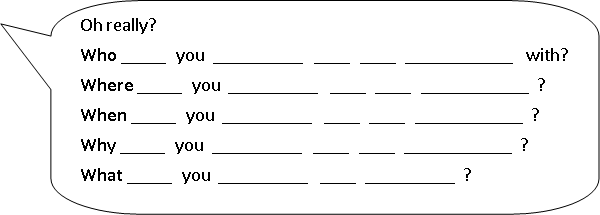
Have students copy the text from the board into their notebooks and then put into pairs to fill in the blanks. After a few minutes, have different students come up to the board to fill in the blanks.
Elicit an answer from the class for the first question (e.g. “I am going to go shopping with my friend.”) and write it under the first question.
Students in pairs write their own answers to the questions in their notebooks. Then go around the class asking everyone for their answers and writing one example below each question.
By now, your board should look similar to this:
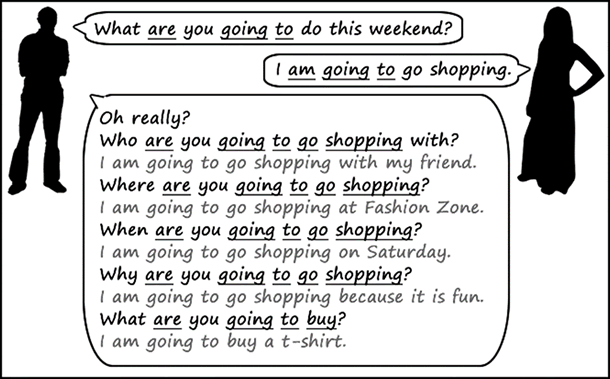
5. Do controlled conversations
Get everyone to stand up and find a partner. Your students are going to have multiple conversations, each time with a different partner. Follow the below process, each time telling students to find a new partner after each conversation:
- Conversation 1: Role play the conversation on the board.
- Conversation 2: Do the same conversation but using the answers in their notebooks.
- Conversation 3: Change the activity (e.g. play tennis, watch TV, etc.). Practice this with 2 different partners.
- Conversation 4: Change “This weekend” to “During the summer”. Practice this with 2 different partners.
Finally, get everyone to sit down and do a check by asking different pairs to stand up and act out a conversation in front of everyone. Be sure to applause and give lots of praise, as well as helping with any mistakes.
6. Play the “What are you going to do … ? True or false” board game
Now students will get the chance to use the structures they have just learned by playing a fun board game. Before class, print out enough copies of the board game sheet and instructions sheet for each group of 2-3 players. You’ll also need a dice for each group and enough counters (anything small) so that each person has one.
Put students into groups of 2-3 around a table and give out the game boards, instruction sheets, dice and counters. Read through the instructions as a class and make sure everyone understands the game.
Then let everyone start playing. Circulate around the class checking that everyone is using the correct structures and help out with any vocabulary issues.
When everyone has finished, ask who won in each group and find our something they talked about.
7. Read classroom reader “Monster school summer plans”
This reader really helps to reinforce the new structures with a fun story. Before class, download and print out the reader “Monster school summer plans”. As you go through each page, point to the pictures of each monster student and get everyone to speculate what their summer plans are, for example:
Teacher: (reading from page 2) “Howzy, what are you going to do during the summer vacation?”, asks Ms. Zarkov.” Look at this picture (on page 3). What do you think Howzy is going to do?
Students: He is going to play tennis!
Teacher: Ok, let’s check. (reading) … “I’m going to play tennis every day. I joined a tennis club and I have six tennis rackets. I’m going to play in some competitions!”. You were right, well done!
Continue through the story, getting everyone to speculate from the pictures.
After reading the story, give out a reader worksheet to each student and have them answer the questions. Finally, go through the answers as a class.
Alternatively, watch our video version of the reader (Internet connection required).
8. Create your own monster story reader
Students can now have a bit of fun writing a monster story and making their own reader.
First, put students into pairs and give out the “Monster story planner’ worksheet. Students work together to create their own characters. Have them draw their own monsters and create names for them. Then have the students think of a summer plan for each monster and write it briefly on the planner sheet (e.g. “throwing cars into space”).
Next, give out the reader templates. Before class, print the four sheets and compile them into a reader, as you would one of our normal readers. Make enough for each pair in the class. Then have pairs write their story using full structures and draw colorful pictures. Allow 10 minutes to complete their readers. As they are doing this, circulate around the classroom checking for mistakes and helping out with questions.
When finished, have students swap and read each other’s readers. You can even have a class vote for the best reader!
Wrap up:
Assign homework: “Weekend plans write” worksheet
Click for wrap up suggestions for the end of your lessons

1. Assign homework
Each week give out a homework worksheet for your students to take home. Hold up the homework worksheet and model how to do it. Give out the worksheets and say, “Put your homework in your bags”.

2. Do “Quick check”
Time to leave the class. Make sure everything is put away and the students have gathered their belongings. Have them line up at the door and place yourself between the door and the students. For each student check one new word or phrase, for example:
- hold up an object or flashcard (such as an item of clothing) and ask, “What’s this?”
- ask a question from the lesson (e.g. “Where do you live?”, “Do you like bananas?”, “Can you play chess?”, etc.)
When they give you the correct answer say goodbye and let them leave. If their answer is wrong, have them go back to the end of the line – they will have to try again once they reach the front!
Other lesson plans
Actions, verbs & tenses:
- Can – for ability
- Morning routines
- Daily routines & times of the day
- Actions – Present continuous
- Future plans using “going to”
- Past tense activities – Regular verbs
- Past tense activities – Irregular verbs: Part 1
- Past tense activities – Irregular verbs: Part 2
Adjectives:
- Describing people
- Describing things
- Comparing things (Comparative adjectives)
- Comparing things (Superlative adjectives)
Adverbs:
Alphabet:
Animals:
Body:
Classroom:
Clothes:
Colors:
Colours:
Directions:
Family:
Feelings & emotions:
Food:
Health & sickness:
Holidays & festivals:
Jobs:
Likes, dislikes & favorites:
Likes, dislikes & favourites:
- Likes & dislikes
- [hide_on_uk]Favorites[/hide_on_uk][hide_on_us]Favourites[/hide_on_us] and asking why
Nature & Our world:
Numbers:
Places & where we live:
Prepositions of location:
Pronouns:
Shapes:
Shopping:
Sports:
Time, days, months, seasons:
Toys:
Transport & travel:
Weather:





